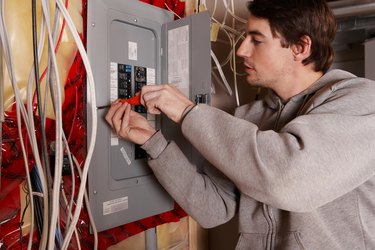Things You'll Need
Non-contact voltage detector
Screwdriver
Stab lock type breaker

A breaker is the brains of your home's electrical system. It protects the branch wiring by turning off the power when it detects an excessive current. This prevents the wires from melting, causing a short circuit and possibly a fire. A stab lok breaker is a specific type of breaker produced by Federal Pioneer. They were commonly used in residential applications and had a tendency not to open when required. Subsequently home owners are now replacing their old Stab lok breakers with a newer design.
Step 1
Turn off the power to the entire distribution panel by opening up the main breaker. Confirm the power is off by touching a non-contact electrical detector to several wires' insulation. Double check the power is off by checking if any device in the home has electricity.
Video of the Day
Step 2
Remove the screws that secure the cover on the electrical panel and set the cover aside.
Step 3
Loosen the terminal screw for the electrical connection on the old Stab Lok breaker and pull out the wire.
Step 4
Pry the existing breaker from the panel starting on its side closest to the center of the panel. This is done by using one screwdriver positioned flat vertically down the center of the panel. Use a second screwdriver resting on the edge of the breaker and the first screwdriver to pry it up in the center. Remove the breaker.
Step 5
Flip the new breaker to the "Off" position. Install the new Stab Lok by inserting the outside first and pushing down on the inside until it locks in place. Give the breaker a gentle pull to make sure it has attached properly. It will move very slightly sideways, but should not pull up at all.
Step 6
Loosen the terminal screw on the breaker and slide the hot wire from the old breaker under the terminal. Tighten the terminal down with a screwdriver.
Step 7
Reinstall the panel cover and turn on the power.
Tip
Avoid touching any wires you don't need to inside the electrical panel. Wires may be live even with the power turned off for various reasons.
Warning
Working around electricity is inherently dangerous because we can't see it. It only takes a few amps to stop your heart. If you are uncomfortable with the process, or the risks, contact a local electrician to change the breaker.
Video of the Day